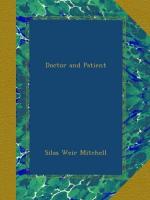A single example may suffice, nor have I any fear that it may lead any one, least of all nature’s gentlest creation, a mother, to be more severe than is reasonable. She it is who is really most responsible. She is ever beside the child when the little actor is off guard. She may have the cleverness to see through the deceit or she may not. The physician comes and goes, and must take for granted much that he has no chance to see, and for which he has to trust the more constant attendant. Moreover, the rarity of these cases is apt to help to deceive him quite as much as does the mother’s affectionate trust. Nevertheless, it is his fault if soon or late he fail to see the truth; but he may well be careful how he states his doubt. The mother at the sick-bed but too often resents as a wrong any hint at the true state of the case.
Children are singularly imitative, and more or less prone to suffer from this tendency. Hence the curious cases in which a child simulates, I do not say dissimulates, the malady it sees constantly before it, as when one child has attacks of false epilepsy, owing to having seen the real attack in a sister or brother, or when St. Vitus’s dance runs through a school or an asylum.
To sum up, we credit these little ones with a simplicity of moral organization which forbids us to believe that the causes which are active for mischief in their elders are not as potent for evil in them. The popular and reasonable creed of moral education, which teaches us to ask from a well child self-control, self-restraint, truth of statement, reasonable endurance of the unavoidable, good temper, is not too lightly or too entirely to be laid aside when sickness softens the rule of health and all our hearts go out in pity to the little sufferer.
Certain of the nervous and other maladies of children sometimes keep them a long while under treatments which are annoying, painful, or disabling. They often end by leaving them as strong as their fellows, but crippled, lame, disfigured, or with troubles that attract remark, or, at least, notice. Thus, a child may have hip-disease, and, after years of treatment, get well, and although vigorous enough to do all that is required in life, be more or less lame. In another case, there is disease of the bones of the spine. After a wearying treatment, it is well, but the little one has a distorted spine,—is humpbacked. Again, we have the common malady, palsy of childhood, and here, too, most probably, there is left a residue of disability, or, at all events, some loss of power.




